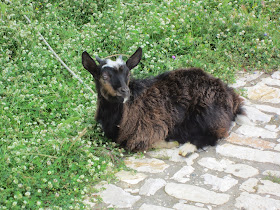After our morning hike up to the Kotor Fortress, we set out for our next destination: Dubrovnik, Croatia. On the map it looked pretty straightforward--just hang tight to the coastline. Our research told us it should take us about 1 hour and 35 minutes. Ha. Try three or four hours.
Good thing I still had some morning Happy Pills given to me in the States by my friend Kathy as travel nourishment. She knows me well. I was proud of myself for having stretched out the bag this long.
At first, it seemed that things were going our way. At some point, a miracle occurred. After not having had GPS for nine days (and through Bosnia, Serbia, Macedonia, Albania, and Kotor), maps and directions suddenly appeared on our device near the Croatian border.
But alas, we would have done better on this stretch on our own. The GPS led us astray. Bob and I differ on how badly we were lost, but I had the printed map unfolded on my lap, and we were
not on any roads marked on the map. After asking directions from non-English-speaking Croats two or three times and doing our best to understand their energetic pointing, waving, and shouting, we finally found our way to charted roads.
It was not the last time we got lost, unfortunately.
The approach to Dubrovnik from the south is exquisite. The road drops down from the hills above the coast, presenting a stunning view of the coastline. The brilliant cerulean sea, bright white buildings with red tile roofs, and verdant vegetation make the scene look like it is photoshopped.
If you look closely at the promontory below, you can see the old city walls that form a jagged circle around Dubrovnik's Old Town.















































.jpg)





